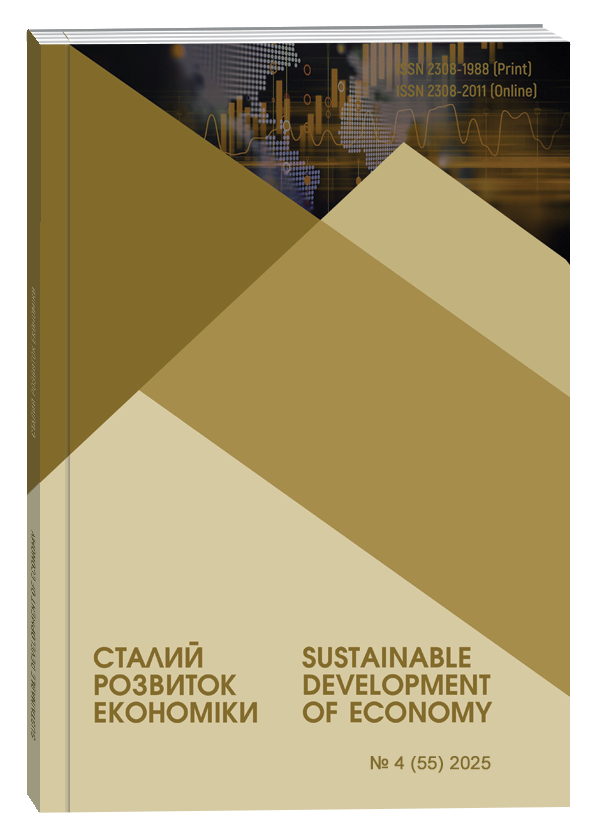FINANCIAL INSTRUMENTS FOR ENSURING THE ECONOMIC AND ENVIRONMENTAL SECURITY OF ENTERPRISES
Abstract
This article examines modern financial instruments for ensuring economic and environmental security of enterprises on the context of global ecological challenges and strengthening sustainable development requirements. The research analyzes theoretical foundations of enterprise economic-environmental security as a comprehensive category combining economic stability with environmental responsibility. The study systematizes and classifies environmentally oriented financial instruments by funding sources, functional purpose, and temporal criteria, investigating the application of green bonds, environmental credits, ESG investments, insurance and compensation mechanisms. The research demonstrates that economic-environmental security represents a multidimensional category characterized by an enterprise’s ability to maintain stable financial performance while minimizing environmental impact and ensuring long-term sustainability. Achievement of this state requires mobilization of significant financial resources through specialized instruments that function as comprehensive mechanisms enabling enterprises to transform environmental challenges into competitive advantages. The classification framework encompasses internal instruments based on enterprise resources including environmental funds, accelerated depreciation, and profit reinvestment, alongside external instruments providing access to larger financing volumes through green bonds, environmental credits, ESG investments, and specialized grants. Functional classification reveals investment instruments for capital expenditure financing, insurance instruments for environmental risk management, and compensation instruments enabling additional revenue generation from environmental activities. The study identifies temporal categories spanning short-term instruments for operational financing, medium-term solutions for project implementation, and long-term mechanisms supporting strategic business model transformation toward sustainability. Analysis demonstrates comprehensive approaches in leading jurisdictions combining regulatory frameworks, financial incentives, and infrastructure development. Key advantages of green financial instruments include access to expanded investor bases, reduced capital costs, enhanced corporate reputation, and alignment with regulatory trends. However, limitations encompass strict transparency requirements, certification complexities, administrative burdens, and market liquidity constraints. The study concludes that successful utilization requires substantial organizational changes, transparency enhancement, internal expertise development, and supportive regulatory environments. State involvement remains critical for market development through favorable policies, infrastructure creation, and targeted incentive provision.
References
Guizhou Wang, Hongrui Cui, Kjell Hausken. (2025). The evolution of green finance research: A comprehensive bibliometric analysis. Heliyon, Vol. 11. Iss. 3. DOI: https://doi.org/10.1016/j.heliyon.2025.e42161
Mudalige, H.M.N.K. (2023). Emerging new themes in green finance: a systematic literature review. Futur Bus, No. 9. Article 108. DOI: https://doi.org/10.1186/s43093-023-00287-0
John Kingsley Woode. (2024). Green finance and green growth: A systematic literature review on awareness, existing channels, instruments, and techniques, Development and Sustainability in Economics and Finance, Vol. 1. DOI: https://doi.org/10.1016/j.dsef.2024.100004
Fu, C., Lu, L. & Pirabi, M. (2023). Advancing green finance: a review of sustainable development. Digital Economy and Sustainable Development, Vol. 1. Article 20. DOI: https://doi.org/10.1007/s44265-023-00020-3
Peterson K. Ozili. (2022). Green finance research around the world: a review of literature. International Journal of Green Economics, Vol. 16. No. 1. DOI: https://doi.org/10.1504/IJGE.2022.125554
Тарасова О. (2022). Особливості сталого інвестування в розвиток еколого-орієнтовної економіки. Вісник Хмельницького національного університет. Серія : Економічні науки, Т. 312. № 6(2). С. 168-177. DOI: https://doi.org/10.31891/2307-5740-2022-312-6(2)-29
Жибер Т.В. (2022). Використання кліматичного маркування як інструменту зеленого бюджетування в Україні: рекомендації та перспективи. Фінанси України, № 5. С. 29-42. DOI: https://doi.org/10.33763/finukr2022.05.029
Козарезенко Л.В. (2023). Детермінанти реалізації принципів «зеленого» бюджетування. Економічний вісник університету, Вип. 56. С. 174-182. URL: http://nbuv.gov.ua/UJRN/ecvu_2023_56_23
Захарченко Н.В, Борисенко Н.В. (2019). Механізми фінансування «зелених інвестицій». Environmental management, № 1(65). С. 166-180. DOI: https://doi.org/10.33271/ev/65.166
Комісарук, Н.О. (2014). «Зелені інвестиції» як форма бюджетного фінансування природоохоронних заходів. Науковий вісник Ужгородського національного університету. Серія : Право, Вип. 25. С. 158–161. URI: https://dspace.uzhnu.edu.ua/jspui/handle/lib/8412
Диба М.І., Гернего Ю.О. (2021). Потенціал фінансування ініціатив зеленого курсу в Україні. Фінанси України, № 2. С. 73-84. DOI: https://doi.org/10.33763/finukr2021.02.073
Латинін М., Біловіцька Ю. (2022). Теоретичні підходи до функціонування механізмів державної політики сталого розвитку «зеленої» економіки в Україні. Науковий вісник: Державне управління, № 1(11). С. 74-91. DOI: https://doi.org/10.33269/2618-0065-2022-1(11)-74-91
Хринюк О. С., Корчовна М. Р. (2015). Система забезпечення економічної безпеки підприємства: основні елементи. Ефективна економіка, № 3. URL: http://www.economy.nayka.com.ua/?op=1&z=3927
Хахалєв, Д., & Немашкало, К. (2024). Інструменти фінансування «зеленого» інвестування в умовах сталого розвитку. Development service industry management, № (2), С. 119–125. DOI: https://doi.org/10.31891/dsim-2024-6(18)
Guizhou Wang, Hongrui Cui, Kjell Hausken. (2025). The evolution of green finance research: A comprehensive bibliometric analysis. Heliyon, Vol. 11. Iss. 3. DOI: https://doi.org/10.1016/j.heliyon.2025.e42161
Mudalige, H.M.N.K. (2023). Emerging new themes in green finance: a systematic literature review. Futur Bus, No. 9. Article 108. DOI: https://doi.org/10.1186/s43093-023-00287-0
John Kingsley Woode. (2024). Green finance and green growth: A systematic literature review on awareness, existing channels, instruments, and techniques, Development and Sustainability in Economics and Finance, Vol. 1. DOI: https://doi.org/10.1016/j.dsef.2024.100004
Fu, C., Lu, L. & Pirabi, M. (2023). Advancing green finance: a review of sustainable development. Digital Economy and Sustainable Development, Vol. 1. Article 20. DOI: https://doi.org/10.1007/s44265-023-00020-3
Peterson K. Ozili. (2022). Green finance research around the world: a review of literature. International Journal of Green Economics, Vol. 16. No. 1. DOI: https://doi.org/10.1504/IJGE.2022.125554
Tarasova, O. (2022). Osoblyvosti staloho investuvannia v rozvytok ekoloho-oriientovanoi ekonomiky [Features of sustainable investment in the development of an environmentally oriented economy]. Bulletin of Khmelnytsky National University. Series: Economic Sciences, Vol. 312. No. 6(2). Pp. 168-177. DOI: https://doi.org/10.31891/2307-5740-2022-312-6(2)-29 (in Ukrainian)
Zhyber, T.V. (2022). Vykorystannia klimatychnoho markuvannia yak instrumentu zelenoho biudzhetuvannia v Ukraini: rekomendatsii ta perspektyvy [The use of climate labeling as a tool of green budgeting in Ukraine: recommendations and prospects]. Finance of Ukraine, No. 5. Pp. 29–42. DOI: https://doi.org/10.33763/finukr2022.05.029 (in Ukrainian)
Kozarezenko, L.V. (2023). Determinanty realizatsii pryntsypiv «zelenoho» biudzhetuvannia [Determinants of the implementation of the principles of «green» budgeting]. Economic Bulletin of the University, Is. 56. Pp. 174-182. URL: http://nbuv.gov.ua/UJRN/ecvu_2023_56_23 (in Ukrainian)
Zakharchenko, N.V., & Borysenko, N. V. (2019). Mekhanizmy finansuvannia «zelenykh» investytsii [Financing mechanisms for «green investments»]. Environmental management, No. 1(65). Pp. 166-180. DOI: https://doi.org/10.33271/ev/65.166 (in Ukrainian)
Komisaruk, N.O. (2014). «Zeleni investytsii» yak forma biudzhetnoho finansuvannia pryrodookhoronnykh zakhodiv [«Green investments» as a form of budget financing of environmental protection measures]. Scientific Bulletin of Uzhhorod National University. Series: Law, Iss. 25. Pp. 158–161. URI: https://dspace.uzhnu.edu.ua/jspui/handle/lib/8412 (in Ukrainian)
Dyba, M.I., & Herneho, Yu.O. (2021). Potentsial finansuvannia initsiatyv zelenoho kursu v Ukraini [The potential of financing Green Deal initiatives in Ukraine]. Finance of Ukraine, No. 2. Pp. 73–84. DOI: https://doi.org/10.33763/finukr2021.02.073 (in Ukrainian)
Latynin, M., & Bilovitska, Yu. (2022). Teoretychni pidkhody do funktsionuvannia mekhanizmiv derzhavnoi polityky staloho rozvytku «zelenoi» ekonomiky v Ukraini [Theoretical approaches to the functioning of mechanisms of state policy for sustainable development of the «green» economy in Ukraine]. Scientific Bulletin: Public Administration, No. 1(11). Pp. 74–91. DOI: https://doi.org/10.33269/2618-0065-2022-1(11)-74-91 (in Ukrainian)
Хринюк, О. С., & Корчовна, М. Р. (2015). Система забезпечення економічної безпеки підприємства: основні елементи [System of ensuring the economic security of an enterprise: main elements]. Efficient economy, № 3. Available at: http://www.economy.nayka.com.ua/?op=1&z=3927 (in Ukrainian)
Хахалєв, Д., & Немашкало, К. (2024). Інструменти фінансування «зеленого» інвестування в умовах сталого розвитку [Tools for financing green investment in the context of sustainable development]. Development Service Industry Management, no. (2), pp. 119–125. DOI: https://doi.org/10.31891/dsim-2024-6(18) (in Ukrainian)


